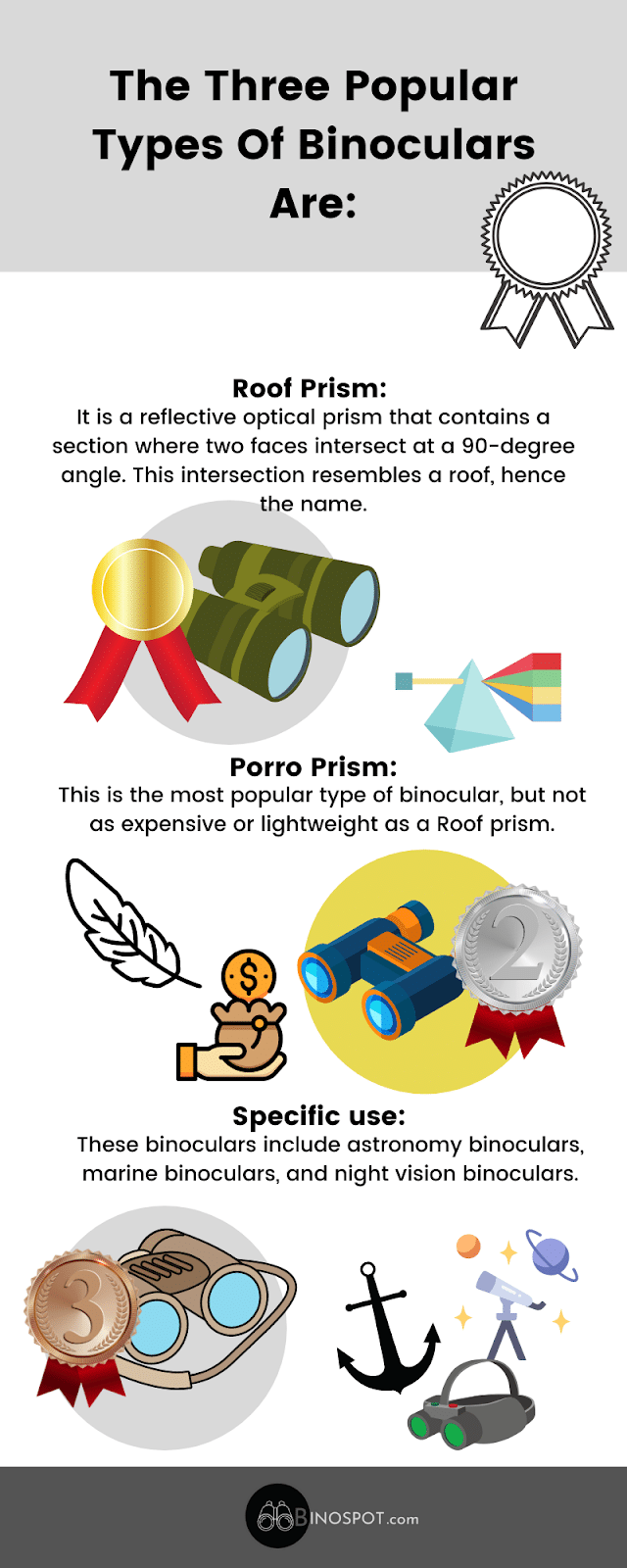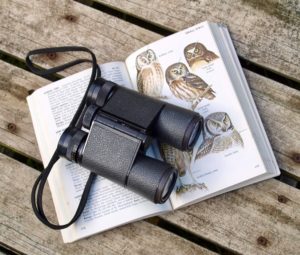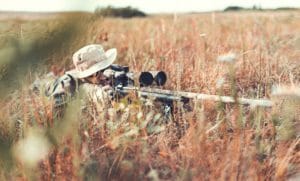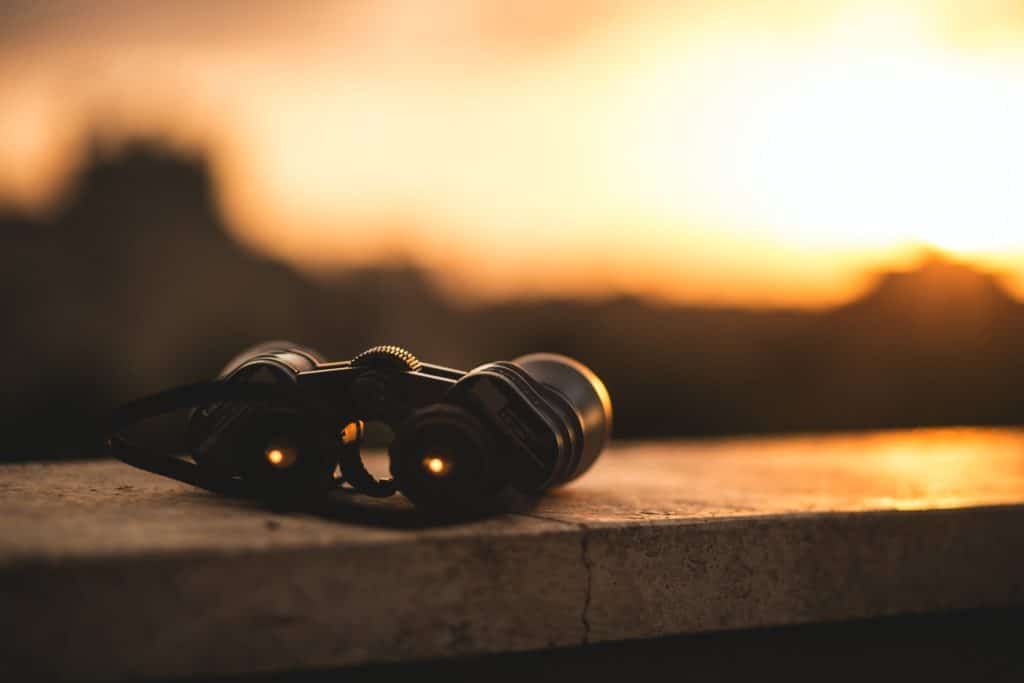Despite the popularity of binoculars today, very few people know the type of binoculars that best suits their outdoor adventure.
Most people often choose binoculars based on what makes them feel better than what’s best for their outdoor engagement. Whether you’re looking for your next pair of binoculars or you’re a first-time buyer, research beyond size and magnification strength is essential.
This article will guide you through everything you need to know about the various types of binoculars available in the market today. It will also help you choose the best binocular set for your outdoor activity. Let’s dive in.
The different binoculars available on the market today are:
- Roof Prism.
- Porro Prism.
- Specific use binoculars.

Roof Prism Binoculars
Binoculars may look like simple technology, but they involve more than magnifying images for your eyes; this is where modern styles, like prisms, come in handy. Without prisms, binoculars cannot turn the magnified image or adequately reflect light, which can frustrate anyone using binoculars.
The two major categories are Porro prism and roof prism. Of the two, roof prisms are modern, more lightweight, streamlined, and straight-tubed. They’re also more compact.
How Does the Roof Prism Binocular Work?
Before we can dive into how roof prism binoculars work, let’s first define it. A roof prism is a reflective optical prism that contains a section where two faces intersect at a 90-degree angle; this intersection resembles a roof.
These two surfaces enable the roof prism to flip the image across the axis later, ensuring you have a right-side-up image. The roof prism splits the light reflection in half, ensuring you receive the correct image.
This complex machination enables the light from your image to enter the objective lenses and bounce around a convoluted pathway—the two faces—before reaching your eyes. This light distribution sequence also enables roof prism binos to produce a brighter end image and a higher magnification power.
The downside of the roof prism binoculars is that these types of binoculars models can be quite expensive. Another con is that these types of binoculars have a narrow field of view.
The common types of roof prism binoculars are:
- Amici.
- Schmidt-Pechan.
- Abbe-Koeing.
Of the three, the most popular roof prisms are Abbe-Koeing and Schmidt-Pechan.
Common roof prism uses are bird watching, hunting, nature observation, sports events, safari, and hiking.
Porro Prism Binocular
The next type of binocular to consider is the Porro Prism Binocular. These binoculars are the most common since Italian Ignazio Porro first developed them in the 19th Century.
Identifying a Porro prism binocular is relatively easy thanks to its objective lens, eyepieces, field of view, and exit pupil. These four aspects dictate the effectiveness of Porro prism binoculars.
How Do Porro Prism Binoculars Work?
The Porro prism works by sending reflective light from your target to the objective lens through an interdependent section of triangular light-catchers in a straight line. The reflective light movement amplifies and helps invert the image, resulting in a sharp, magnified image.
However, the interdependent triangular section makes the binoculars cumbersome and can be quite tiring to carry around. It also means a lower magnification. Despite the downsides, the Porro prism binocular provides a good 3D image compared to the roof prism. It also has a wider field of view and is cheaper than the roof prism binocular.
Common uses of Porro prism binoculars include sporting events, general use, astronomy, hiking, and scouting.

Specific Use Binoculars
Unlike the Roof Prism and Porro Prism binoculars, the specific use binoculars are built with a particular purpose in mind, and each comes with several features that make them stand out. They are:
Night Vision Binoculars
After sunset, hobbies like watching wildlife, hiking, and hunting become more challenging because of the lack of light; this is where night vision binoculars come in handy. These binoculars extend your favorite activity late into the night and help you spot animals despite the darkness; they’re also quite useful in activities that require low-light, like hunting.
What makes these types of binoculars different is their image quality. The images are sharp and clear, especially during low-light situations. They also come with infrared illuminators that enable you to see in the dark.
The field of view and magnification power of night vision binoculars are also higher, as they enable you to see far away targets. However, keep in mind that a higher magnification means a lower field of view. Make sure you stick to a magnification that won’t significantly reduce your field of view.
One downside is that night vision binoculars are quite pricey.
Common uses are low-light situations like wildlife observations, nighttime explorations, hunting, or surveillance.
Astronomy Binoculars
Most people often assume they can only stargaze with a telescope, but a binocular can also perform the same task, especially if they’re designed for that purpose.
Despite having a lower magnification and being smaller than a telescope, it offers a wider view; this makes it easier to find celestial objects, which is something any amateur astronomer or avid stargazer dreams of.
You also get to use both eyes and have a natural view compared to a telescope. Just like any other binocular, this one does come in different variations. Some are compact, while others require a tripod to mount.
The type of astronomy binoculars you choose depends on the field of view you desire. Larger models have a wider field of view than a typical telescope, but they’re cumbersome and more costly.
Typical uses are examining heavenly bodies and the night sky.
Marine Binoculars
These types of binos are explicitly designed for use around or in water. Compared to typical binoculars, marine binos come with specific features that set them apart. One hallmark feature is its compass; this feature projects the magnetic bearing of the image.
It also has a rangefinder reticle, a horizontal line, and a vertical scale projected across the image; this enables users to determine the distance of the target using simple geometry. However, some models have simplified this feature by including a laser system that accurately determines the target’s distance.
Lastly, another essential feature of marine binoculars is that they’re also fog and waterproof binoculars, which guarantee no damage even when they fall in the water. Apart from their features, these binos have a wider objective lens and a lower magnification, enabling users to have a wider view.
The only downside about these binos is that you’ll have to part with quite a bit of cash, as they aren’t cheap.
Common uses are whale watching, marine operations, diving, or ship gazing.
Additional Binocular Categories
Other binocular categories you can consider are:
Mini Binos
Most of the binoculars on the market are large and clunky. But if you want a pair that’s easy to fit in your pocket, you can go for mini binoculars. Other than being compact, they also come with sufficient eye relief and objective lenses that are worth using.
Zoom Binoculars
These types of binoculars are perfect for honing or zooming in on your target after you’ve completed scouting. The only disadvantage is that you’ll end up losing some of your target’s surrounding environment when using them.
Focus-Free Binoculars
If you’re looking to train your child how to use binoculars, then focus-free binos are perfect; they don’t require focus, as they’re inherently designed to focus at a particular range. They also come with an exit pupil that enables users to see the image as brightly as possible.
Don’t Be Caught off Guard
Understanding the different binoculars available today can mean the difference between a horrible or exciting outdoor adventure. Ensure you make your choice based on what your hobby requires.








